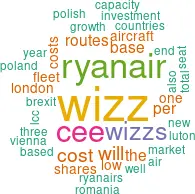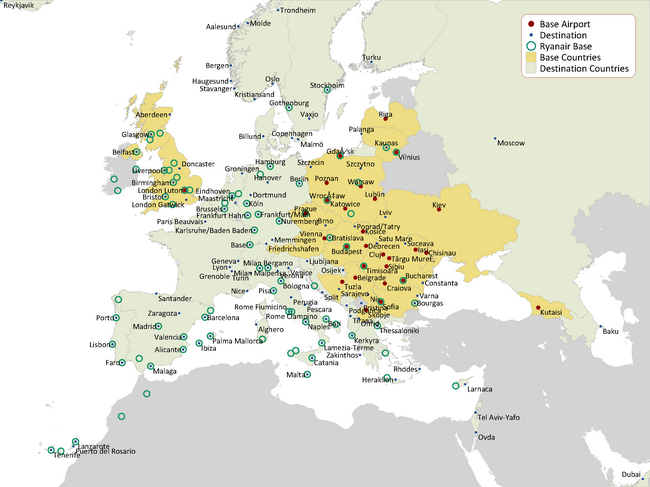Wizz defies Brexit
and Ryanair
March 2018


On a comparison of European LCC shares, Wizz has markedly outperformed its three low cost rivals in recent months. Investors clearly believe in its ULCC model and growth prospects for Central East Europe (CEE).
The share price performance has also to be seen in the context of the decision by its original investors, Indigo Partners (see Aviation Strategy, February 2018) to cash in their 18.7% stake in June 2017, raising about €260m in the process, although they retained convertible shares and notes that could entitle them to an additional 24.3m shares in Wizz (the current float is 73m shares).
The similarities to Ryanair are an obvious attraction. Wizz’s unit costs in the third quarter of FY2018 were 3.23€¢ per ASK (2.29¢ ex-fuel), roughly equal to those of Ryanair at a similar average stage length. Like Ryanair, and unlike say easyJet, Wizz’s top management is wedded to core low cost principles; József Váradi, the CEO, has been there since the start in 2004, during which time Wizz, from its Budapest headquarters, has seen off its local LCC rival SkyEurope and the Hungarian flag-carrier Malév.
There are major differences with Ryanair as well, particularly in the scale of operations — Wizz operates a fleet of 92 A320/321s while Ryanair has 420 737-800s. Ryanair’s revenue, estimated at €7.1bn for FY2018 is nearly four times that of Wizz, €1.9bn for FY2018, Wizz profitability is not quite at Ryanair’s level — an EBIT margin of about 15% against 23%. Despite the recent price movements, Wizz’s stockmarket capitalisation — €2.8bn — is dwarfed by Ryanair’s €18.7bn.
Still, Michael O’Leary might just be regretting his throw-away remark of several years ago: when asked about rumours about a Ryanair bid for Wizz, he said he wouldn’t pay €1 for the airline.
As the map illustrates, Ryanair and Wizz bases overlap everywhere in the CEE; they are the two main competitors. Wizz’s own analysis puts itself at 39% of the LCC CEE market, Ryanair at 32%, easyJet at 6% and others (Norwegian, Pegasus, Flydubai, Vueling, Volotea, etc) at 23%. Significantly, Wizz places itself as the number one operator out of nine of 13 CEE countries.
Vienna is the latest battleground. Wizz selected Vienna as a new base earlier this year, claiming an investment of €265m, which presumably refers to the cost of the three based A321s, and adding 17 new routes in 2018. Ryanair has just agreed to buy an initial 25% stake in Vienna-based Laudamotion, formed out of insolvent carrier Niki, previously part of Air Berlin, which will eventually rise to 75%. The declared investment in a base which is expected to operate 30 aircraft in three years time appears modest — €100m in total. Intriguingly, Ryanair says that one of the benefits of Laudamotion is that it will will provide it with essential experience of Airbus operations.
Underpinning Wizz’s ultra low cost structure is its CEE location. Although it has to compete for pilots at international rates, being able to base its aircraft in low cost country brings down most other labour and overhead-related costs. At the end of FY 2017 the majority of its aircraft — 45 out of 87 at the end of FY 2017 — were based in Poland and Romania, and the rest in other CEE countries, with the exception of one A320 at London Luton. GDP per capita in Poland and Romania is €9,800 and €7,500 respectively compared to €33,000 in the UK.
However, over the past year Wizz has been rapidly building up its Luton base. Having purchased all of Monarch’s slots, following that airline’s bankruptcy, it has allocated eight A320/A231s to this airport from where it operates to 47 destinations. Wizz’s own estimate of its investment at Luton is €690m, again presumably including based-aircraft purchase prices.
Back in October Wizz Air UK, a fully owned subsidiary, applied to the CAA for a UK Air Operator’s Certificate and Operating Licence to be used alongside its existing Hungarian licences in the post-Brexit world (it also holds a Ukrainian licence). The UK licences were expected by this March but do not seem to have been delivered as yet; resolving nationality/ownership issues proving tricky.
A shift in balance to high cost bases like London and Vienna will put pressure on costs, but Wizz’s other cost driver is its fleet policy. Growing at 20%-plus a year, Wizz fleet development is centred on the 239-seat A321neo, gradually replacing 180-seat A320s.
Wizz’s orderbook is impressive — a total of 281 aircraft — 8 A320ceos, 72 A320neos, 17 A321ceos and 184 A321neos. By the end of FY2020 the fleet will comprise 127 units, up from 92 at present, and over half the seat capacity will be from A321s. In its investor presentations, Wizz costs the latest A321neo order (146 units at the Dubai airshow in October) at $17.2bn, or $118m per unit. Given Indigo Partners’ purchasing power, we would expect a 40-50% discount off this valuation, which seems to be based on list prices.
Wizz’s growth story is its base in Central/ East Europe (CEE) — relatively immature economies, but with GDP growth rates of around 4% pa, at least double those of Western European countries. Wizz highlights the difference in propensity to travel — 0.4 flights per person in the CEE against 1.8 flights per person in the West.
However, Wizzair’s core business is linking the CEE with the UK. As the chart above shows, eight of Wizzair’s top ten routes are from CEE capitals or major cities to the UK, to London specifically. And this brings up the horrible question of Brexit.
The UK has benefited from a remarkable wave of immigrants, mostly skilled, from the CEE, initially Poland plus the Czech Republic and the Baltic states, then latterly Romania and Bulgaria. There are estimated to be almost one million Polish residents in the UK, and Polish is the second most widely spoken language. Their residency rights are, hopefully, to be protected under the Brexit deal, but it appears inevitable that this inflow will change into an outflow (if nothing else, the depreciation of sterling has reduced the incentive to working in the UK). VFR trips could increase for the remaining population, perhaps stabilising traffic flows.
This is going to be a big challenge for Wizz, but it is a very resilient company. To get an idea of its competitiveness we have looked at capacity trends on Wizz’s main routes from the CEE to the UK, comparing trends with Ryanair on these routes UK (these routes are all to London from Wizz, and do not cover the total country-pair traffic volumes).
Overall, Wizz comes out very well. This market has grown by 10% pa during 2010-17, and Wizz has increased its share from 31% to 44%, while Ryanair has gone from 20% to 27%, and all the others have dropped from 49% to 30%. In the key Polish market, Wizz and Ryanair matched capacity almost exactly in 2013, since when Wizz has surged ahead. It also leads Ryanair in the new CEE markets of Romanian and Bulgaria, as well as its home country, Hungary.
Notes: Based on 2017 schedules. London = all airports. Poland = Warsaw (Chopin and Modlin), Gdańsk, Katowice, Poznan. Romania = Bucharest, Cluj. Hungary = Budapest, Debrecen. Bulgaria = Sofia. Lithuania = Vilnius, Kaunas. Latvia = Riga
